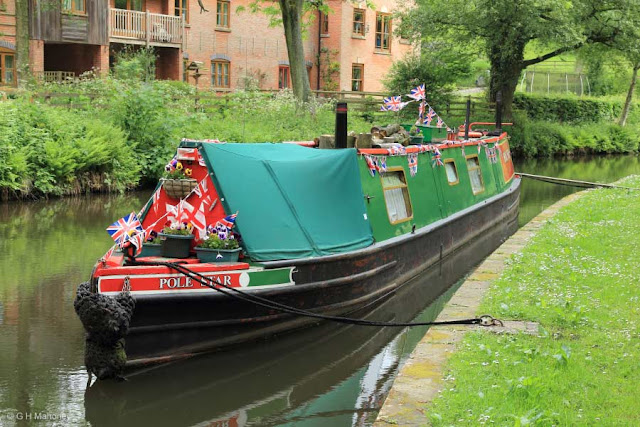 |
| In Lathkill Dale |
(Canon EOS 60D, Sigma 17-70mm @ 17mm, 1/320s @ f/7.1)
At last! A glorious spring day. I took a walk from Monyash to and through Lathkill Dale, one of the most beautiful of the Derbyshire Dales. The following set of photos chronicles to walk.
The Bull's Head in Monyash is the start (and a welcome end!) to the walk. It is of typical White Peak construction having limestone walls with some gritstone as lintels and corners for strength.
The village cross, on the green in front of the pub, dates from the 13th century. Monyash was granted a charter for a weekly Tuesday market in 1340 and for an annual 3 day fair.
The top of Lathkill Dale. At this point the valley is dry, devoid of a river or stream. This will change as we progress through the dale.
Cattle graze peacefully on the lush spring grass at the top of the dale.
The limestone outcrops through the turf frequently. I think of this as "the bones of the earth".
Ricklow Quarry where once decorative limestone was mined. The limestone, rich with fossils, was polished and used in furnishings.
Early Purple Orchid growing on the steep grassy banks above the dale. Rather than walking through the bottom of the dale, I climbed up to the northern edge and walked high above the valley for some superb views.
Above Ricklow Quarry looking east along the line of upper Lathkill Dale.
Looking back towards the top of the dale and Monyash village.
The dale winds its way to the east. There is still no sign of the river Lathkill.
The cliff on the right is called Parson's Tor. The name comes from one Robert Lomas, vicar of Monyash, who in 1776 fell to his death from the cliff while riding home in fog. His horse survived.
A side valley, Cales Dale, branched off. We will later be leaving Lathkill Dale by way of this valley.
Another view looking east along Lathkill Dale. The name comes from the old Norse
Hlatha-gyll meaning "barn in a narrow valley".
One of the stiles along the valley top path. This one had a nicely shaped and very handy post to help me over.
Cowslips
Looking away from the dale, here is one of the many sheep farms on the limestone plateau, this is Mill Farm.
A steep descent took me down into another side valley, unnamed on the OS map, with a green lane leading down to the River Lathkill.
The valley is quite heavily wooded at this point, and from here further downstream.
Looking up the green lane in the side valley.
Getting close to the River Lathkill at last.
The River Lathkill passes over many small rapids and weirs on its way down to join the River Wye near Bakewell.
One of the many small weirs.
The banks of the river have many flowers including these Forget-me-nots, Red Campion, Bluebells, Ladies Bedstraw and others.
Remember the shot of Cales Dale from earlier? Here is the footbridge that is to take me across the river to leave Lathkill Dale.
Looking up river from the footbridge. The stream is much smaller here, only a few hundred meters from its emergence from underground at Lathkill Head Cave. During the summer the river can disappear completely and run underground for a considerable distance.
This attractive plant in Cales Dale is Meadow Saxifrage
Saxifrage granulata.
The path climbs out of Cales Dale to join the Limestone Way long distance path and pas through One Ash Grange. The grange was once a place of punsihmentt for wayward monks from Roche Abbey in Yorkshire. This interesting row of pigstys still has the stone feeding stations at the front of each sty.
A small cave at One Ash Grange has been made into a Nativity scene. Perhaps a little out of time in May.
We now cross some very good pasture land with contented cows "as far as the eye can see"!
The dry limestone walls divide up the parcels of good grazing land on the plateau.
A walled farm track leads back down to the village of Monyash.
Fere Mere, seen here, is the only remaining one of five ancient meres which provided a supply of water to the village. The natural meres were reinforced with clay bottoms to assure a supply of winter during the dry summer months. This is the end of our walk. I hope you enjoyed it as much as I did!







































































